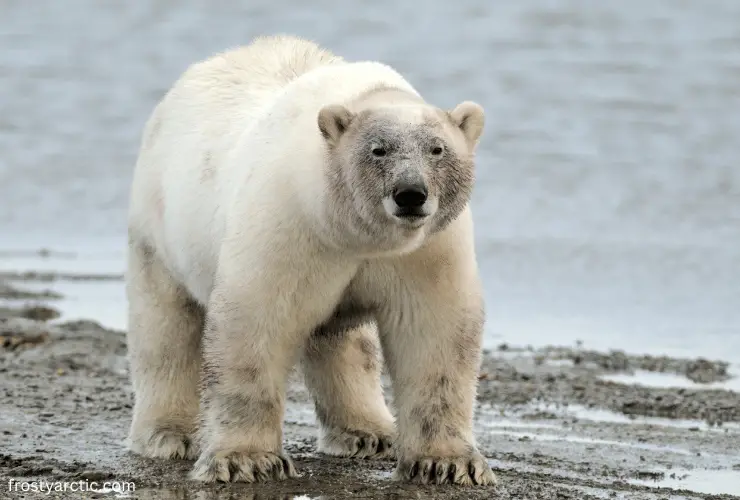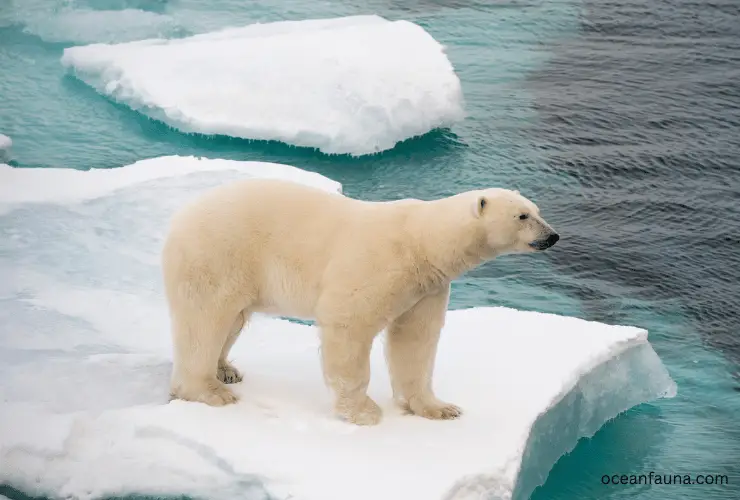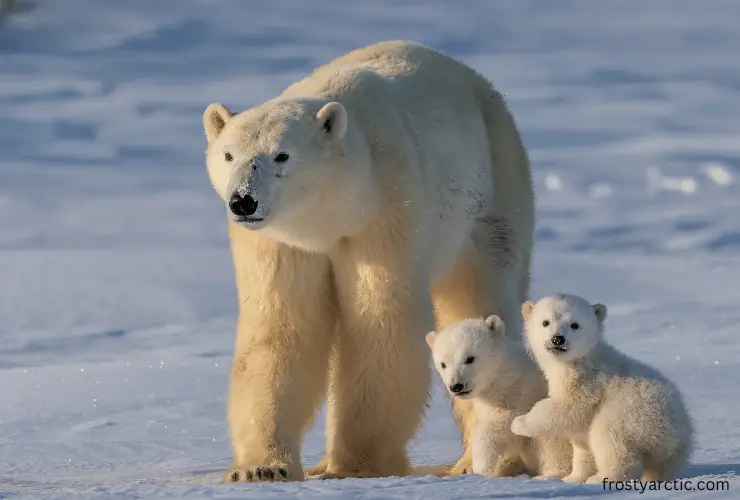Polar bears have white fur to camouflage in the white environment of the Arctic. Their white fur blends so well into the environment that we often see polar bears as snow drifts. Interestingly, the skin of polar bears is white, but their fur is not actually white. The fur of polar bears is hollow and translucent, with no white pigments.
Did you know that polar bears’ coats are double layered, which keeps them warm in freezing temperatures? Today, our complete focus is on one of the identifying features of polar bears – iconic white fur. Let’s see what furry facts about these apex predators are still hidden!
Why Do Polar Bears Have Black Skin but White Fur?
As we mentioned in the introduction, polar bears have white fur in order to camouflage in the snow and ice of the Arctic. Now, why do they camouflage? And, what is the story of the black skin of polar bears even though their fur is white? All these questions need attention. Let’s discuss all the possible reasons why they have black skin but white fur, according to the preference of WWF:
1. Camouflage to Hunt Prey
Polar bears have white fur to camouflage in order to hunt their favorite prey – seals. Seals do not see the polar bears when they blend in the white background of the Arctic. In this way, polar bears hunt their prey in a moment of seconds. The seals do not find any way to save them due to repta-like attacks of polar bears.
2. Camouflage from Other Predators and Threats
Polar bears use camouflage methods to hide from other predators and any other threat. Their white fur is the perfect physical adaptation of polar bears that helps them to camouflage from predators. The biggest enemies of polar bears are humans and polar bears themselves. And so, the camouflage technique makes it easier for them to remain hidden from these enemies. The fur’s white coloration also reduces the likelihood of being detected by other animals.
3. Thermoregulation

Polar bears have black skin, not white like their fur. Their black skin can better absorb and retain heat from the sun. Black color absorbs more sunlight. This adaptation helps keep the bear warm in the cold Arctic environment. Moreover, the black skin is not visible under the fur, which enhances their stealth.
4. UV Protection
The black skin offers protection against harmful ultraviolet (UV) radiation. This is particularly important in the Arctic where the rays of the sun are intense. Also, the reflection of the snow and ice can increase UV exposure.
5. Skin Pigmentation
The genetics responsible for skin color and fur color are different. The gene that determines fur color is separate from the one that determines skin color. This reason leads to the contrast that polar bears have black skin but white fur.
6. Evolutionary History
Over generations, polar bears adapted to their environment. Their dark skin is a trait inherited from their ancestors. You know their ancestors were living in more temperate regions and had darker skin for heat absorption. As polar bears evolved This is one of the valid reasons why polar bears have white fur but black skin color.
All these reasons are interconnected and contribute to the overall survival of polar bears in their environment.
Do Polar Bears Have Clear Fur?
Polar bears have clear and transparent fur but not entirely clear. Thanks to its special features and characteristics. These characteristics help the bear’s fur appear white. According to most sources like the Library Of Congress, the coarse guard hairs are transparent and hollow. Contrarily, the thinner hairs of polar bears that grow in the undercoat are not hollow, but colorless.
According to the report of Ocean Conservancy organization, polar bears have two coats of fur:
- Outer layer
- Undercoat layer
The outer layer is protective but not as dense as the undercoat layer. However, the undercoat layer helps them to survive in the harsh climate of the Arctic. The double layer offers not only thermal protection but also effective camouflage in snowy surroundings. This layer greatly aided their hunting endeavors.
Also Read: What Does a Polar Bear Sound Like?
Polar bears are very careful and possessive about their fur. They always try to keep the fur neat and clean. Simply, dirty fur is not acceptable to polar bears. Then, how do they clean their white fur? They try to take a shower in the icy water to clean their fur. Also, they roll in the snow to cool down or clean up their bodies.
Do Polar Bears Always Have White Fur?

Polar bears are known for their white fur. However, their fur is not always perfectly white. The appearance of the fur of polar bears varies due to a few factors:
1. Staining
The fur of polar bears is designed to repel water and snow. Over time, their fur becomes stained from things like algae or dirt. Any other substance that comes into contact with them also changes their fur color.
2. Seasonal Changes
We know that the Arctic ice melts in the spring and summer. The fur of bears appears slightly yellowish due to oxidation of the fur and exposure to sunlight. However, this is temporary, and their fur looks brighter white in the winter.
3. Age
As the polar bears grow older, their fur color starts changing. That’s why older polar bears have fur that appears more yellow or even brownish. This color change is due to the accumulation of stains over their lifespan.
4. Individual Variation
Humans have variations in hair color. Similarly, there is an individual difference in fur color among polar bears. That’s why some polar bears have slightly off-white or cream-colored fur.
Is Polar Bear Fur Transparent?
Yes, the fur of a polar bear is transparent. According to the study of Ocean Conservancy organization, we found the following shocking fact:
“The fur/hair of polar bears is not conventional or common fur like other bears and animals. The hair shafts of polar bears are totally hollow from the inside. Their fur beautifully reflects the sunlight. As a result, the fur of Arctic bears appears white. It also appears yellowish, creamy, or light brown, sometimes.”
The Senior Manager and Digital Outreach Specialist, Megan Montemurno, also states that the thick coat of polar bears is so specially designed. It means their transparent fur directly absorbs the heat from sunlight. The hollow fur is basically a better way for the black skin that is underneath the fur to absorb more heat.
When the temperature reaches below -30° F, then this adaptation is very helpful. Also, the study at the Library of Congress clearly shows that the fur of polar bears is transparent. There was a time when researchers were recording a tidbit that polar bear hairs have similar properties that are present in optical fibers. But this was the wrong theory.
Fun Fact Time
Have you ever seen the green fur of polar bears in zoos and captivity? You probably have seen them with lighter green fur. This is the algae that gives them a little greener look. The algae grow in the hollow fur of polar bears. It doesn’t mean polar bears cannot maintain pure white fur in zoos and captivity. They simply need a perfect “filtration system” to maintain clean and clear fur! ~ Source
Why Do Polar Bears Have Thick Fur?
The two main reasons why polar bears have thick fur are as follows:
- Insulation: We all know that polar bears live in extremely cold environments. In this case, their thick fur acts as an insulating fur. This adaptation helps them retain body heat. The fur traps a layer of air close to their skin to create a barrier against the cold.
- Waterproofing: Polar bears are excellent swimmers and spend a lot of time in the water. Their fur has a special ability to repel water. This type of fur prevents it from soaking in and reduces the ability of bears to stay warm while wet.
- Protection: The fur of polar bears is long and dense. It offers some protection against minor injuries. It also helps them to shield their skin from the harsh Arctic elements.
The above-mentioned factors ensure that polar bears are well adapted to the tundra region.
What Do Polar Bears Look Like Without Fur?

According to the research of the World Wildlife Federation, polar bears look just like their fellow cousins, the black bears. Their real jet-black skin will reveal without fur. It means they would appear darker. They would also look weird without a fur coat. Their real iconic look will disappear.
You know they have black colored skin due to black pigmentation. The disadvantage of polar bears’ looking and living without fur will not be cozy at all. They lose hair due to infections and wounds. Genetic problems are also the main cause of shaved polar bears. There are many documented cases of shaved polar bears living in captivity and zoos.
Conclusion
The importance of translucent fur and black skin of polar bears is not a secret anymore. Their hair is made up of keratin just like the hair of a human. Keratin is a protein compound that has a subtle ivory hue. It additionally adds to the white appearance of polar bears’ fur. They also have tiny salt particles inside their hair along with air. Thus, everything is in favor of polar bears to make them appear white in the snowy areas of Arctic land. All because to blend them seamlessly into their habitat.
Have you ever noticed why polar bear cubs are born with brown fur? Kindly share your views with us in the comments section. Your feedback matters a lot!



6 thoughts on “Why Do Polar Bears Have White Fur?”